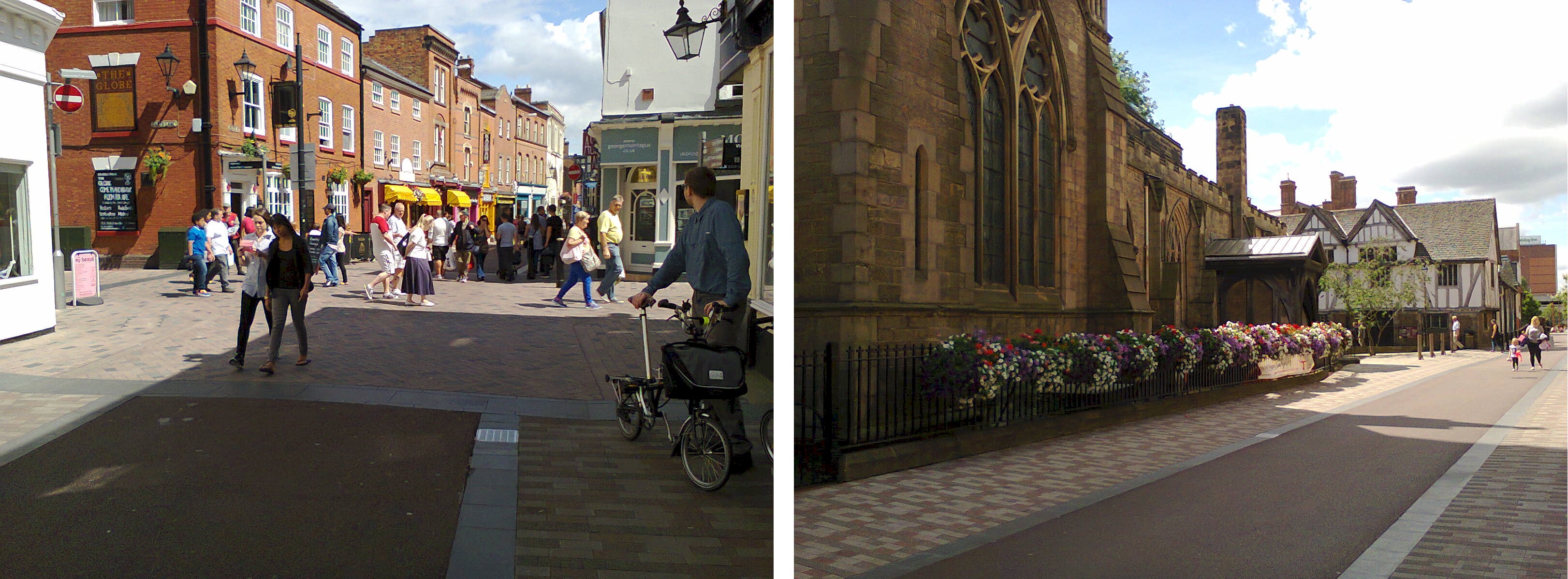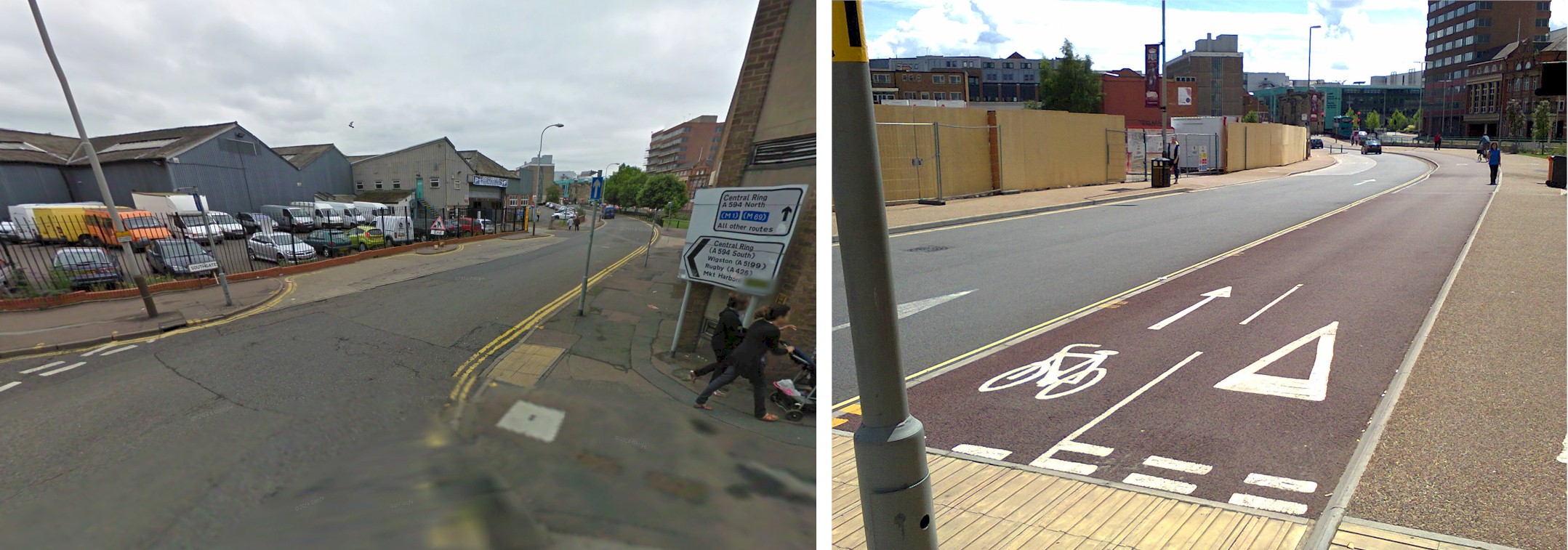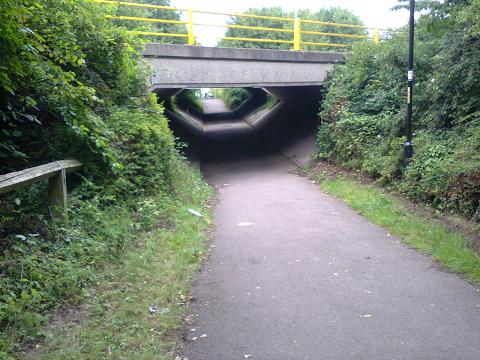
Leicester has been attracting the attention of cycling campaigners because the city council is getting on with the job of building proper cycling infrastructure. It has done so without any Cycling Ambition Grant funding, and the city council has shown itself willing to take space away from motor vehicles. They have already used techniques most commonly seen in the Netherlands to make the city centre people-centric, and now they are extending that good practice outwards, where it is connected with whatever was built in the past.
 The first sign that Leicester is moving into a sustainable future can be found within a minute of getting off the train. Cycle parking is provided in the covered portico at the entrance to the station (additional parking is provided by a cycle hub). The design of the stands leaves a lot to be desired, but that can be changed in the future and the location is as convenient as it can get. As if to prove it wasn't always this way in Leicester, in the grand tradition of 1960s motor cities a monstrous ring road must be crossed to reach the central business district from the station. People arriving on bikes are at least allowed to cycle on the pavement, and in fact this pavement hides a far uglier past. Until 2010 pedestrians would have used a subway to get across a six lane road. Naturally the subway had 90 degree bends at the end, which would have made it feel threatening. Subways don't have to be built this way, but the city council opted to replace it with a two-stage toucan crossing to get across a four lane road. The space gained has been used for wider pavements, cycle parking, and a couple of painted cycle lanes. That's still very far from how the Dutch would arrange things, but it shows that closing two lanes of the ring road could be done without Leicester descending into chaos, which is not what British transport planners would have us believe.
The first sign that Leicester is moving into a sustainable future can be found within a minute of getting off the train. Cycle parking is provided in the covered portico at the entrance to the station (additional parking is provided by a cycle hub). The design of the stands leaves a lot to be desired, but that can be changed in the future and the location is as convenient as it can get. As if to prove it wasn't always this way in Leicester, in the grand tradition of 1960s motor cities a monstrous ring road must be crossed to reach the central business district from the station. People arriving on bikes are at least allowed to cycle on the pavement, and in fact this pavement hides a far uglier past. Until 2010 pedestrians would have used a subway to get across a six lane road. Naturally the subway had 90 degree bends at the end, which would have made it feel threatening. Subways don't have to be built this way, but the city council opted to replace it with a two-stage toucan crossing to get across a four lane road. The space gained has been used for wider pavements, cycle parking, and a couple of painted cycle lanes. That's still very far from how the Dutch would arrange things, but it shows that closing two lanes of the ring road could be done without Leicester descending into chaos, which is not what British transport planners would have us believe.
 It's once you're across the ring road that things are very different. At first glance the photo of Granby Street, right, doesn't look much different from any other town in the UK, but in fact it has more in common with a Dutch town. Courtesy of contraflow cycle lanes, cyclists can go in either direction. Motorists on the other hand find themselves in a maze of one way streets that don't really go anywhere, and as a result are only of any use for access. Thus motorists are a minority group and they drive slowly and cautiously. That means cyclists and pedestrians are not bullied by the presence of motor vehicles. That sort of environment encourages cycling and makes the city centre very much more pleasant in general. It also means that if you need to get a motor vehicle into the city centre, you can.
It's once you're across the ring road that things are very different. At first glance the photo of Granby Street, right, doesn't look much different from any other town in the UK, but in fact it has more in common with a Dutch town. Courtesy of contraflow cycle lanes, cyclists can go in either direction. Motorists on the other hand find themselves in a maze of one way streets that don't really go anywhere, and as a result are only of any use for access. Thus motorists are a minority group and they drive slowly and cautiously. That means cyclists and pedestrians are not bullied by the presence of motor vehicles. That sort of environment encourages cycling and makes the city centre very much more pleasant in general. It also means that if you need to get a motor vehicle into the city centre, you can.
Granby Street takes you into the heart of the largest pedestrianised area in the UK, and the way this has been done is delightful. Many different surfaces have been used, but they are all very high quality and they are laid to create the impression of traditional streets. Not only is this visually attractive, it gives cues as to where it's best to walk, and where it's best to cycle, since visually there is a carriageway with a pavement either side.

Guildhall Lane. See what it looked like in 2009
 This attention to making the built environment look good is also a feature of Dutch infrastructure. Finding yourself bumping along a cycle path that looks like it was built as an afterthought, with half worn carriageway paint and bike icons that look like they were painted by a toddler is dispiriting, and does nothing to encourage people to use it. Technically the contraflow lane shown left could be better. In particular it is very narrow, but the slight upstand on the kerb doesn't make it easy to use the carriageway for overtaking or social riding if there is no oncoming motor traffic. The smooth hump separating it from the footway does allow cyclists to cross over on to the footway safely, but that is not something that pedestrians would appreciate. However, the new arrangement here replaces a scruffy one-way only carriageway, and the huge aesthetic improvement enhances social safety. Social safety is important if you want people to get about without feeling the need to be locked in a metal box. A contraflow lane improves permeability for cyclists, allowing them to shorten journeys and overcome the disadvantage of a low maximum speed. At the same time, the one-way street can be used as part of a wider scheme to block through motor traffic from where it is not wanted, but motorists are still allowed to use the street, both for driving and parking. All this has been achieved within the bounds of the existing, narrow street. So despite the shortcomings, this is still excellent.
This attention to making the built environment look good is also a feature of Dutch infrastructure. Finding yourself bumping along a cycle path that looks like it was built as an afterthought, with half worn carriageway paint and bike icons that look like they were painted by a toddler is dispiriting, and does nothing to encourage people to use it. Technically the contraflow lane shown left could be better. In particular it is very narrow, but the slight upstand on the kerb doesn't make it easy to use the carriageway for overtaking or social riding if there is no oncoming motor traffic. The smooth hump separating it from the footway does allow cyclists to cross over on to the footway safely, but that is not something that pedestrians would appreciate. However, the new arrangement here replaces a scruffy one-way only carriageway, and the huge aesthetic improvement enhances social safety. Social safety is important if you want people to get about without feeling the need to be locked in a metal box. A contraflow lane improves permeability for cyclists, allowing them to shorten journeys and overcome the disadvantage of a low maximum speed. At the same time, the one-way street can be used as part of a wider scheme to block through motor traffic from where it is not wanted, but motorists are still allowed to use the street, both for driving and parking. All this has been achieved within the bounds of the existing, narrow street. So despite the shortcomings, this is still excellent.
 The junction behind the camera viewpoint of the photo taken looking towards Guildhall Lane is an example of one designed to restrict the movement of motor vehicles whilst allowing cyclists greater freedom. Typically in the Netherlands cyclists would be free to ignore all the no entry signs here (maybe that is planned for later work, since it would appear from Grey Friars that the city council like to build contraflow cycle lanes rather than just permitting contraflow cycling). However, cyclists can go in both directions on Gray Friars, something motorists cannot do. For motorists this junction requires some thought before proceeding. The driver of the BMW in the photo was not unusual in taking some time to decide what to do next, so much time that I actually managed to calmly take a photo on the other side of the street and on this side of the street before the car moved. This delay didn't result in irritated honking from the car behind, because there was very little motor traffic, and when it did move, it did so slowly and carefully. That is a consequence of the built environment making motorists feel like perhaps they shouldn't be there.
The junction behind the camera viewpoint of the photo taken looking towards Guildhall Lane is an example of one designed to restrict the movement of motor vehicles whilst allowing cyclists greater freedom. Typically in the Netherlands cyclists would be free to ignore all the no entry signs here (maybe that is planned for later work, since it would appear from Grey Friars that the city council like to build contraflow cycle lanes rather than just permitting contraflow cycling). However, cyclists can go in both directions on Gray Friars, something motorists cannot do. For motorists this junction requires some thought before proceeding. The driver of the BMW in the photo was not unusual in taking some time to decide what to do next, so much time that I actually managed to calmly take a photo on the other side of the street and on this side of the street before the car moved. This delay didn't result in irritated honking from the car behind, because there was very little motor traffic, and when it did move, it did so slowly and carefully. That is a consequence of the built environment making motorists feel like perhaps they shouldn't be there.
Of course there is no point having a city centre that enables cycling if there is no reasonable way to get to the centre. Leicester has started taking away space from motor vehicles and creating wide cycle paths of a kind normally seen only in continental European countries. For example, The A47 has been disconnected from the city centre, and now there is just an access road. Also the carriageway of the slip road down to the ring road has been narrowed. These changes have allowed the council to build a 2.85metre wide segregated cycle lane along the edge of these two roads. What was scruffy, worn out infrastructure built for car use is now renewed, attractive, and very much cycle-friendly. Far from being a disaster, the adjacent city centre is thriving.

The cycle path continues across the ring road to the westbound A47, where the city council has created space for cycling by placing a line of wands along the left-most lane divider. The world has not ended; motor traffic is still flowing. However, now cyclists can feel safe using the A47, and as more and more people cycle, so there will be less and less need for wide roads and bloated junctions.


 Beyond the city centre there are examples of typical British low quality, inadequate cycling infrastructure, such as hopelessly narrow lanes painted on to bumpy pavements (photo left), giving way with an even bigger bump at every private driveway (photo right), indirect backstreet routes, and routes that feel socially threatening even on a sunny day. However, even this older infrastructure is not all bad. The example shown right may be poor, but it's not very long and it links the high quality new infrastructure above with the wide railway path, The Great Central Way, that carries NCN6 way out into the countryside.
Beyond the city centre there are examples of typical British low quality, inadequate cycling infrastructure, such as hopelessly narrow lanes painted on to bumpy pavements (photo left), giving way with an even bigger bump at every private driveway (photo right), indirect backstreet routes, and routes that feel socially threatening even on a sunny day. However, even this older infrastructure is not all bad. The example shown right may be poor, but it's not very long and it links the high quality new infrastructure above with the wide railway path, The Great Central Way, that carries NCN6 way out into the countryside.
The Great Central Way is just a shared-use path, but it is mostly of a good width, properly surfaced with bitmac, properly lit, and well signposted. Despite it being wide enough for a car, Leicester City Council has not felt the need to barricade every access point with a stymie gate. All in all, cycling on it is a very different experience to cycling on the sort of shared-use path favoured by Birmingham City Council. That, along with it connecting almost completely off-road to the city centre, is perhaps why there were so many cyclists of all ages and backgrounds using it.
It would be crazy to say Leicester is a mini Holland, but the city council is making a serious attempt at changing a British motor city. They are using high quality materials to create usable cycling infrastructure, and are forcing the balance in favour of cycling rather than hoping for the balance to change. The effect is already obvious in the central business district. It is visually appealing, relatively pollution free, and quiet. Those very features will be allowing the wide range and large number of shops, restaurants, and cafés to thrive. The beneficial effect of removing motor traffic has been proven over and over again, but Leicester has proved it works on a grand scale.
Whilst the council is making an attempt to link up sections of cycle-friendly infrastructure, the network design falls a long way short of what the Dutch do. There they design infrastructure holistically, so different modes of transport avoid each other, but they do not achieve this by diverting cyclists on to circuitous and socially unsafe routes. Additionally, the Netherlands has a comprehensive network of routes, that in an urban area will be dense. But it seems churlish to criticise, given the excellent changes that have been made in this Midlands town.
Leicester Cycling Campaign Group






